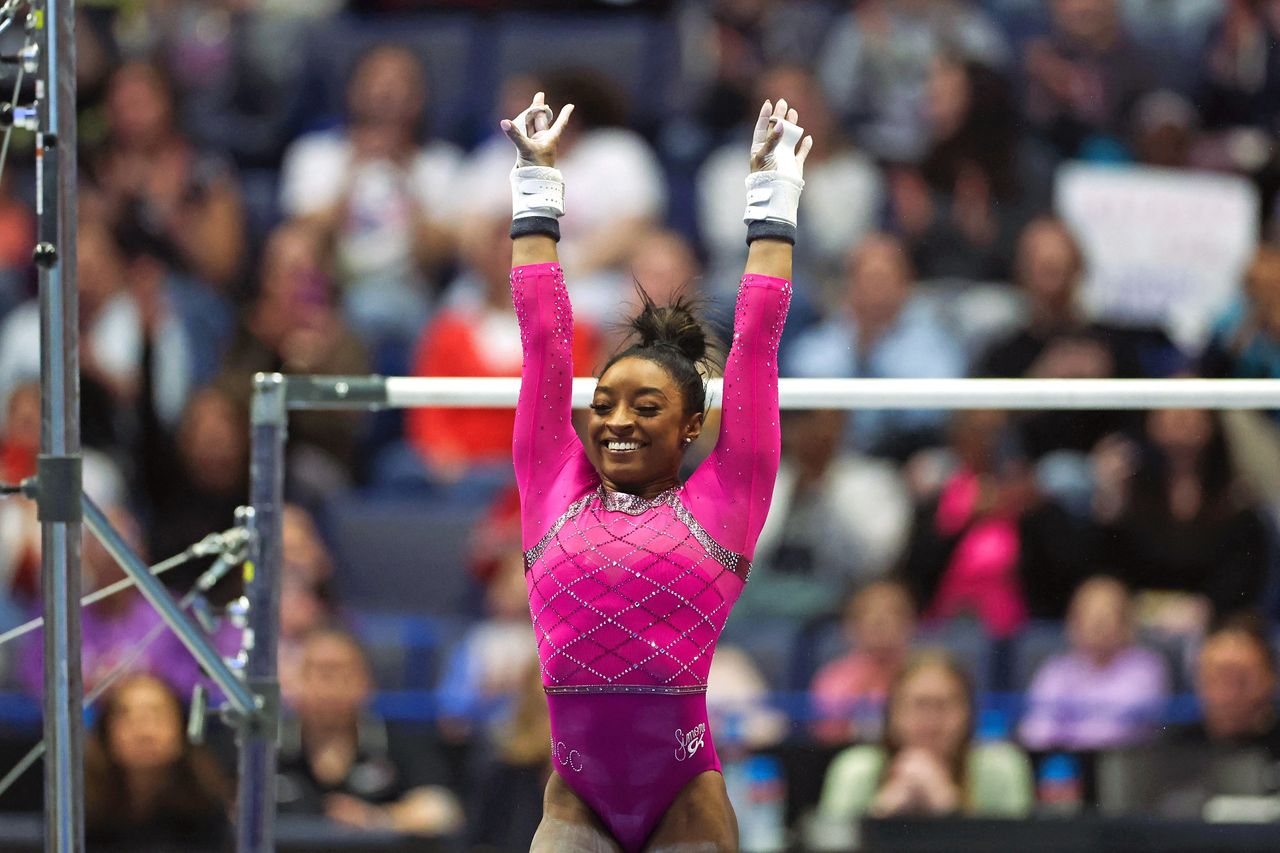
SIMONE BILES IS DOING SIMONE BILES THINGS AGAIN
HARTFORD, Conn.—When Simone Biles made a seemingly impossible return to competitive gymnastics last year, the athlete who had dominated every competition for more than a decade picked up right where she left off.
She reclaimed the U.S. all-around title. She was crowned world all-around champion, again. She snapped up an additional four world medals to become the most decorated gymnast in the sport’s history. And she did it all by a considerable margin over her nearest rivals.
Yet there was one way in which Biles wasn’t all the way back: the outlandishly difficult skills that had been a hallmark of her gymnastics were more restrained. She spent 2023 executing tough moves well, but was more cautious with the most extreme ones that had allowed her to shatter the boundaries of the sport’s rulebook.
She didn’t need to bring back the triple-twisting double tuck—three twists, two turns in the air—that once summed up everything brilliant and terrifying about Biles’s gymnastics, but which she hadn’t attempted in competition since the shaky qualifying round in Tokyo that preceded her withdrawal from the Olympic team final, mid-event.
Now, two months out from the Paris Olympics, she’s bringing it back anyway.
To a reception of ear-piercing cheers on Saturday night, Biles broke out the triple-double during her floor exercise as she kicked off her Olympic season at a meet that’s typically a soft launch for the national championships.
In returning to the pinnacle of elite gymnastics, Biles has already achieved the improbable. When she pulled herself out of five finals in Tokyo after “the wires just snapped” and she found herself unable to perform skills she’d done for years, it seemed unfathomable that she would ever return to the bright lights of competition.
That she’s now letting her most difficult gymnastics rip once more, at the age of 27, and as she embarks on a third consecutive Olympic cycle, counts as extraordinary.
“This year is a little bit different. Last year it was more of, like, making sure mentally I was feeling safe and confident doing whatever skills we chose to do,” Biles said in an interview with The Wall Street Journal ahead of the competition.
“Now I feel a lot more comfortable and confident in twisting, so we’re adding back the triple-double and stuff like that.”
Soon after the triple-double, Biles shook off another restraint. Last year, she only performed the eye-poppingly difficult Yurchenko double pike vault with her coach Laurent Landi standing by to spot her—even though his presence incurred a mandatory 0.5-point deduction.
This time, he stood far back and just watched.
“She’s been doing it without him for a while now, and she just feels ready. Honestly, she was ready last year, I think Laurent was not ready last year,” said Cecile Landi, Biles’s other coach. “I think he needed to see her do it like she’s done it.”
To her coaches, these are all signs that “she’s mentally and physically fit,” Cecile Landi said. “She’s way more relaxed and enjoying competing and having fun, and truly, I think she really found why she’s doing it.”
Heading into the last Olympics, Biles had been able to simultaneously twist and turn in the air more than anyone else in the history of women’s gymnastics. Then, seemingly, she was left broken by the difficulty of what she was attempting, as well as the toll of an array of other pressures.
Those included the crushing expectation of being the undisputed favorite every time she pulled on a competition leotard, but also the burden of being the only self-identified survivor of Larry Nassar still competing in elite gymnastics.
Recently, Biles has openly connected the “twisties” that she experienced in Tokyo—a sudden loss of air awareness that is a well-known phenomenon to gymnasts—with the overwhelming levels of stress that she was under.
“It wasn’t just a mental injury that happened called the twisties,” she said in an interview on the Call Her Daddy podcast. “It’s compressing all of this shit for so many years—it just unfolded. You can’t compress trauma that much longer.”
What makes her triple-double especially astonishing now isn’t just the amount of twisting it requires—it’s how far Biles has had to come to attempt it again.
“Every time I went to the gym, it was kind of traumatizing. Every time I’d flip, I’d just get flashbacks to Tokyo: ‘I’m going to get lost. I’m going to get lost,’” she recalled on the podcast.
Biles was one of three Olympic all-around champions on the competition floor in Hartford, the 2016 winner lining up alongside Sunisa Lee, who won the most coveted crown in the sport in Tokyo in 2021, and the U.S. heroine of the 2012 London Games, Gabby Douglas.
Douglas, now 28 years old, was trying to get a qualifying score that would allow her to compete in the all-around competition at the U.S. championships in two weeks. But she had a disastrous opening on the uneven bars, coming off twice.
She finished the routine, urged on by a crowd chanting “Gabby, Gabby,” but withdrew from competing on the other three apparatus.
Lee, who is 21 years old, has been diagnosed with kidney diseases that severely hampered her ability to train in the last year. She turned in solid performances on the balance beam, floor and vault, and will debut a new uneven bars routine later in the month.
“I really just wanted to get out there and compete again,” Lee said. “We’re still working on that routine and it’ll be a surprise for the next couple of competitions.”
Even in a field that sounds like a gymnastics fan’s fever dream, though, the suspense was all around Biles—and how she would look when the season-end is Paris, with the five Olympic rings that make everything different.
What she showed is just how much stronger she is.
Write to Louise Radnofsky at [email protected]
2024-05-18T12:14:56Z dg43tfdfdgfd